Let’s say you just invented something that puts sliced bread to shame. Something that will improve lives by the million.
You have a website and a logo. You even have a few ideas for commercials.
There’s just one problem: Nobody knows you exist… and your industry is stacked with competitors.
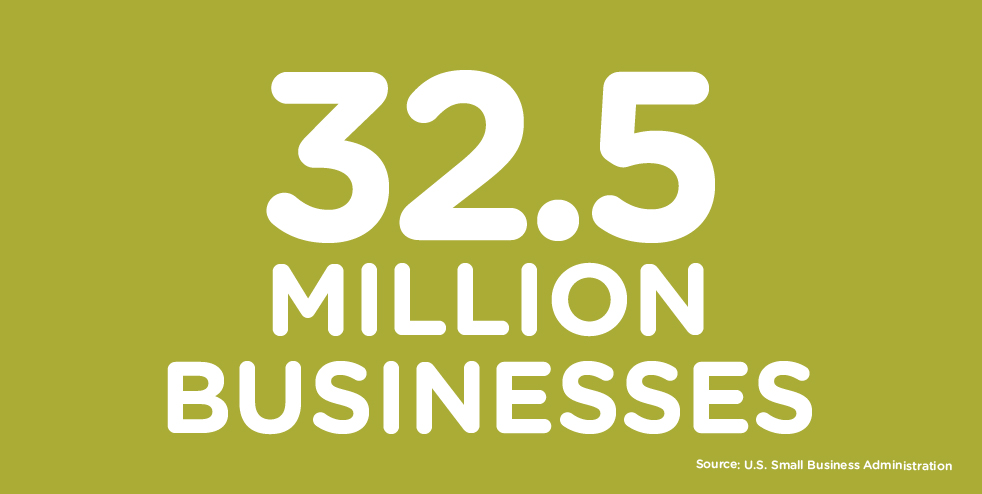
In short, you need a media buying strategy — pronto.
Let’s dig into the whats, whys and benefits, shall we?
Spending Your Media Budget Smartly.
A couple hundred years ago, there was really just one medium: The newspaper. So, anyone could buy space in the local rag for a few pennies.
Not much strategy involved there, right?
But then came magazines. Then billboards. And radio followed by TV and trade magazines. Then the internet and wearable internet. Each of those mediums has hundreds — or hundreds of millions — of advertising placement options.
# TV stations:
1,775+
# Radio stations:
15,000+
# Newspapers:
6,000+
# of US websites:
133 million+
# of magazines:
7,400+
And since the general rule of thumb is that you should spend around 7% of your budget on marketing, you need to be mindful of how — and where — you deploy your resources.
That’s a major reason to have a media buying strategy. But not the only one.
Media Buying Strategy Benefit #1: Achieving Communication Goals
What’s one thing that every company has, but is different for every company?
Goals.
Your company might be a shiny new startup that’s scrounging pennies to get your brand out to the masses (or niche).
Your business could be a century old, searching for more leads (not sales) with millions of dollars to spend.
Yes, everyone has a different goal by which they measure success — but success rarely happens without a solid strategy in place.
Media strategy agencies like Stealth Creative move businesses forward by zooming in on your priorities first, then zoom out to generate a plan for desired results. This is an important distinction.
Why?
Because some media is more conducive to certain goals than others.
Digital is Best Suited For:
Specific targeting Generating real-time data Fine-tuning performance
TV Works For:
Creating effective consumer connections Broad reach Telling stories
Radio is Perfect For:
Efficiency Large audiences Driving online brand searches
Out of Home Enhances:
Broad-reach appeal (billboards on highways)
Niche messaging (individual screens at gyms)
Use Social Media For:
Highly-visual elements
Product demonstrations
Engaging with customers
Print is Ideal For:
Making lasting impressions through physical interaction (holding, turning pages) A more “hands-on” interaction
Your media team will help figure out the right mix based on your goals.
Benefit 2: Data-Driven Delivery
Media planners and strategists are nerds — and they aren’t ashamed to embrace it. Excel is to them what water is to fish. They view data in all its forms as the missing element that makes any strategy really sing.
In fact, media teams make every decision by running the numbers ragged. And a
mathematically-based plan of attack is one of the main reasons why you need a media strategy:
Since media planners put data and analytics under a microscope, they shine at:
Segmenting your audience
Optimizing campaign or spend for constantly improving results
Determining return on ad spend (ROAS) effectiveness
Plotting share of voice, brand recall and other key metrics
Stealth Creative’s media team understands the strengths and weaknesses of each medium and knows which best aligns with the results clients want within their budget.
And our media buyers also understand the nuances between different platforms. For example, different OTT vendors can serve “similar” ad experiences, but they vary on who can be targeted, when and how impressions are delivered and other variables that must be weighed.
Everything is factored to create a plan that has the highest likelihood to achieve — or exceed — the stated goals.
Benefit #3: Right Place, Right Time, Right Message
Pretend for a moment that you sell mattresses and your media team has a strategy to run two different spots: One late at night and one early in the morning.
Why would they do that?
Because the messaging can be different. If a commercial is running at 1 am and an insomniac sees your ad (commercial or banner), the takeaway should be about how your mattress is an instant lights out miracle.
But if someone doesn’t get a deep sleep, the messaging they see or hear on their way to work could be about how they’d feel wide awake if they gave your product a try.
Working with a media planning team not only helps ensure your ideal audience receives your message, they help guide the strategy to help make sure the message makes sense in the context it appears. This 360° thinking is more likely to happen with a full-service marketing agency like Stealth Creative.
Benefit 4: More Bang For Your Bucks
In business, just about everything is negotiable — and that includes media pricing.
As we noted in our marketing myths blog, media buyers can leverage their expertise and connections to negotiate buys at lower rates. Why? Because certain mediums can be like the Costco of marketing; when you buy in bulk, you get better rates. And when you plan media for multiple companies, you are more likely buying multiple time slots, issues, etc.
But there are other ways media buyers can sweeten the deal for you:
Bonus spots
Better placements
Digital elements like banner ads or site takeovers
These are just some examples of what can be negotiated or included in a well-rounded media buy. And your strategist won’t be afraid to play a little hardball to get the best possible deal to achieve your goals.
Benefit 5: Monitoring Your Marketing
Just like any stock market investor will check their 401(K) balance from time to time, it’s natural for companies to want to know how their media investments are doing. Good media planners hold scheduled meetings with clients to discuss performance, tweaks, reconciliations and recommendations pertaining to the strategy.
During these calls, certain data will also likely be discussed:
- Ratings
- Impressions
- Bonus deliveries
- Impact on leads/sales
In certain circumstances — especially digital — you might be able to log in to your own dashboard to see the number of views, clicks and other metrics for a more-or-less real time idea of your campaign’s performance.
Here’s the bottom line: You should expect and trust your media team to make the entirety of your relationship turnkey so you can focus on other things. And they should always be available to communicate the status of your strategy.
Benefit 6: Fresh Ideas, New Opportunities
Media evolves. New competitors and technology come to market. Most importantly, though, opportunities arise.
Just because an annual plan is made at the onset, that doesn’t mean your media team will be sitting on their hands.
Not at all.
Instead, they will (or should) be paying close attention to the national and local landscape in search of the latest and greatest developments, eager to bring these to your attention. Similarly, they should be eyeing consumer sentiment shifts and other measures to proactively modify your strategy and set you up for however you define success.
For example, although the NFL broadcast schedule was set during the summer, ABC and Disney made a deal in mid-September to air an additional eight Monday Night Football games on ABC. Your media team is paid to be on top of these breaking opportunities.
Media Buying Strategies Have Even More Benefits
Indeed, there are literal books on this topic. And while we could make this page infinitely long, you’ve got things to do… like maybe finetuning the strategy for your media buy.
Why not get in touch with the Stealth Creative media specialists? You’ll save time, money and give your business the best shot at achieving its marketing goals.

Brian Reinhardt
Brian Reinhardt is a Senior Copywriter at Stealth Creative whose first unpublished story was penned at the age of eight. Yes, it involved hoverboards, lasers and robots. His days are filled with researching, content creation and SEO strategy. His nights are spent with family, reading and managing too many fantasy sports teams. Nine is his favorite number.
In case you missed the news—you’ve got to adapt or die in this Digital Age. And for brand managers and business owners alike, building a strong online presence is crucial for success.
As we often say at Stealth Creative: Your website IS your brand; it acts as a virtual gateway for customers to discover and engage with your products or services.
So, as long as your website leaves a good first impression, you’re all set. Right?
Turns out, it’s not that simple. Because not all websites are created equal. To ensure your online platform effectively represents your business and reaches your target audience, it’s vital to invest in a website that’s built to best-practice specifications.
Let’s explore the key steps involved in creating a website that not only looks great but serves you exactly how it should.
Step 1: Wireframes and Site Map
The first step for developing your website is building a solid foundation. Wireframes and a site map serve as the blueprint for your website, outlining its structure, navigation and key functionalities. At Stealth, we understand how crucial it is to work closely with clients at this stage to ensure we have clear understanding of YOUR business goals, target audience and desired user experience.
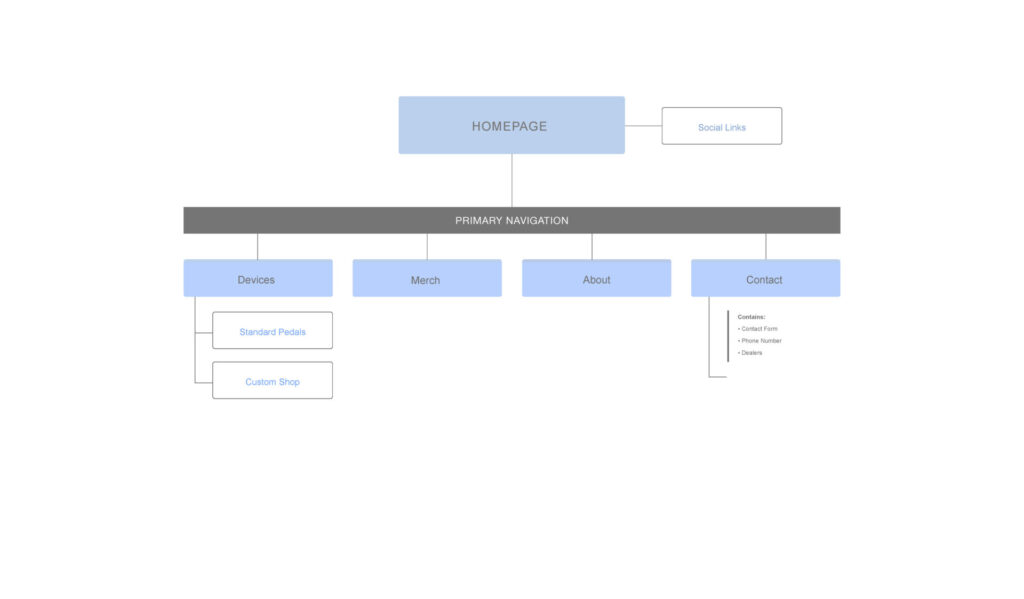
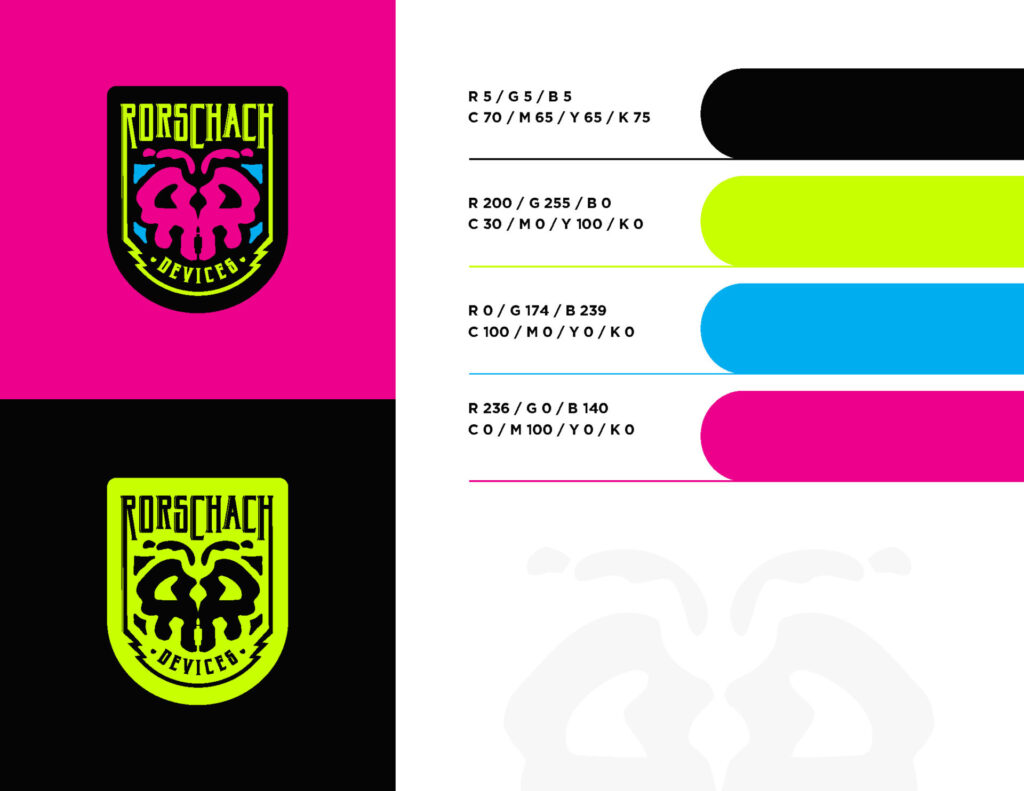
Step 2: Design Phase
Once the wireframes and site map are approved, the design phase begins. Aesthetics play a key role in engaging your website visitors. This is where you get to meet our design team! They love to collaborate with clients, helping to spin their visions into a appealing and cohesive experiences. Logos, color schemes, brand guidelines and any specific design elements that reflect your brand’s personality are developed (or incorporated if already existing). This collaborative process will help create a website design that not only looks stunning but also reinforces your brand’s message and values.
Step 3: Development and Launch Phase
After finalizing the design, the development phase takes center stage. Stealth’s skilled developers will transform the approved design into a functional website, employing best practices for coding, responsiveness and usability. And since more than half of overall web traffic comes from mobile devices, we take a mobile-first approach to design and development. This phase may involve content creation, integration of e-commerce functionalities and customization based on your needs.
Throughout this process, we prioritize regular communication with you, so you can provide timely feedback and we can agilely address you concerns or modifications. Once the website is thoroughly tested and refined, it’s time for the highly anticipated launch.
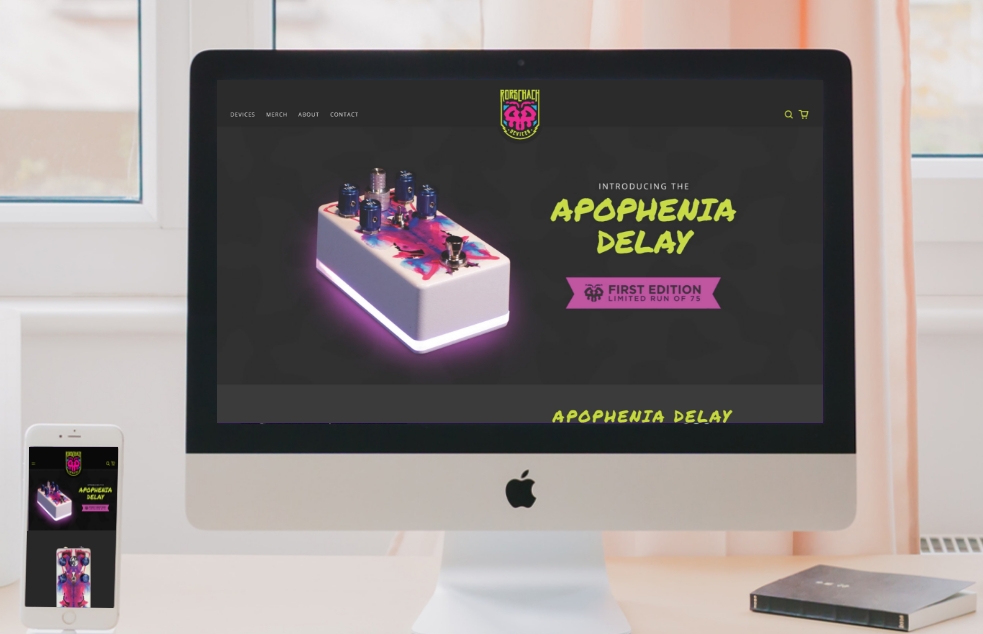
Step 4: Initial Search Marketing Promotion of New Site
Your newly built website is ready to be unveiled to the world, but its success relies on driving traffic and attracting visitors. Incorporating search marketing strategies is the key to improving your website’s visibility in search engine results.
This is where Stealth’s digital marketing experts work to ensure SEO elements, such as keyword optimization, meta tags and proper site structure, are in place. Depending on your business’s needs, our content team can also help to create engaging and shareable content to attract organic traffic and explore paid advertising options to amplify your website’s reach.
You Get Back What You Put In.
Investing in a well-built website is an investment in your business’s success!
By partnering with an experienced agency like Stealth Creative, you can be confident that best-practice specifications are followed, and you can ensure your website is optimized for performance, user experience and search engine visibility.
Check out our Web Services page to get a sense of what we can do. Then, drop us a line when you’re ready to start your website build. We can’t wait to be your guide!

Jack Eschmann
Jack Eschmann is a Senior Copywriter who has worked on both the account service and creative sides of the advertising business. He enjoys crafting messages that are strategically sound, action driving and true-to-brand for each client he serves. He is also a leading member of Stealth’s content team, is an avid musician and production nerd—and can often be found laying down voiceovers in the agency’s production studio.
There are two phrases we hear around this time: “April showers bring May flowers” and “Spring Cleaning.”
No surprise, because according to Statista, 78% of us do some kind of spring cleaning every year. But that doesn’t just have to mean purging your closet or scrubbing baseboards. Today, we’re giving you some tips on how you can spring clean your marketing strategy.
#1 Declutter Your Assets
While there are assets that you should keep handy – logo files, for example – there are plenty that could likely move to an archive. For instance, creative or copy files that have already been produced can be moved to a server or hard drive. This way, you can still access them, but they won’t be taking up precious desktop space. Decluttering gives you a chance to take inventory of what you have in your library – while also allowing for inspiration when it’s time to freshen up those assets!
#2. Ensure You’re on Target
If it’s been a while since you’ve examined your target audience and messaging, now is the perfect time to look “under the hood” of your marketing strategy!
Ask yourself these questions:
- Who is my ideal audience? Why?
- Where can they be found?
- How has my audience grown, changed or shifted in behavior?
- Most importantly, where can they be found?
Because if you aren’t where your target audience is, you need to think about how to get there.
#3 Inventory Your Strengths
While you might keep some marketing in-house, consider if letting a trusted partner help expand your team’s capacity makes sense. Picture this: You no longer expend energy improving your social strategy or media placement. Instead, you get to do what you do best: run your business!
While we can’t help you organize your life, we can help you organize your marketing strategy. If you’re looking for a partner who wants you to succeed as much as you do, we’re here to help.
Kirsten Hackett
One huge advantage of digital marketing is that real-time data is available to show you how effectively your campaign is engaging your audience. Another advantage is that you can use that data to make informed decisions about ways to increase that engagement, even mid-campaign.
That’s why it’s important to work with a marketing partner who believes in the power of data and has the experience and discipline to read and respond to the story it tells.
At Stealth Creative, we’re devoted to data. We think being able to identify key metrics, dig into the numbers and communicate results in clear language is table stakes. What we do with those results to fine-tune tactics, placement and frequency is the real difference-maker.
To the person with only a hammer, all problems look like nails.
Because our digital clients represent a wide array of industries, we use an assortment of digital tools and platforms to drive the results they desire. Whether it be ecommerce, ticket sales, form fills or email opens, we never lose sight of our goal to deliver a strong return on investment for our clients.
We may design a programmatic digital display campaign to reach a custom audience, create and optimize an ecommerce search campaign, drive form fills, create segmented content for an email campaign and improve a customer’s Google review ratings—all to ensure our clients’ marketing dollars are being spent efficiently.
Here are some examples:
Ecommerce FTW
A recent ecommerce search campaign for one of our national health and beauty clients produced a return on ad spend of 33:1. Not only did we track spend and correlate it with product sales, through access to their ecommerce and Google Analytics, we also were able to identify the users who made purchases from the campaign, which products they purchased, the dollars spent and other identifying characteristics. With this information, the client was able to send personalized messages to folks who made purchases for similar products or routine maintenance.
Reach for the Stars
We all know how important online reviews have become for companies. Some of our clients have asked us to help them develop a strategy to engage with customers so they will leave reviews or contact the company directly if they are not satisfied with the product. By working with one of our clients in the insurance industry, we identified customers who had recent contact with the company and created a personalized email asking them to leave a 5-star review. This approach resulted in a significant increase in the ratings for our clients.
Getting Social
A well-planned and developed social media campaign helped one of our entertainment clients set a record attendance at their event. More than $56,000 in ticket sales resulted from a spend of $3,600.
Making a Stronger Impression
Our media buying, from traditional to digital, is handled in house, resulting in greater efficiency for our clients. We took the Joplin Convention and Visitors Bureau’s digital media buying in house and reduced their cpm by 40 percent, which allowed us to buy an additional 1.2 million impressions. For more details, check out this case study.
News that Just Clicks
Madison Mutual Insurance Company wanted to increase the opens and clicks on their policyholder newsletter. Our solution was to segment the newsletter by geography and policyholder type. The result was an increase of 36 percent in opens and 250 percent increase in clicks. For more details, read the full story.
Want to know more?
Spend some time with our other case studies or drop me an email at ckolsky@stealthcreative.com.
About the Author
Charlie Kolsky is a digital and analytics specialist who’s dedicated to delivering results for our clients. He’s also a pretty mean pickleball player.
Maybe your company has its external, customer-facing communication dialed in to a T.
You’re seeing results. Sales are up.
That’s great! But have you been putting the same effort into your internal messaging?
It’s okay to admit if you haven’t. The customer comes first, right? Right. But…
While maintaining relationships with customers and winning new ones may be your primary objectives, keeping your people engaged and informed should be just as much of a priority. Strong internal communication not only helps maintain the health of your company, it also helps protect the bottom line.
And it’s not as simple as repurposing your existing customer communications or firing off a few company-wide emails. You’ve got to be strategic and consistent from the ground-up.
In other words, you have to be in touch with the intrinsic values of your organization.
Invest in ‘The Employee Experience’
Work environments and employee priorities are evolving at a quicker pace than ever before, so it’s never been more important to make sure your HR and workforce teams are on the same page.
The journey your employees take during their time at your company and the various factors that affect their satisfaction, productivity and longevity—that’s the employee experience.
Benefits, compensation, work-life balance, work environment and company culture all shape this experience, but a good internal communication strategy should be the common thread that unites all of these elements. Because:
-
-
A good employee experience fosters loyalty. You want to retain and grow the employees you have. Not only because turnover inherently costs more, but also because experienced employees can become powerful ambassadors for your brand.
-
A good employee experience means you’ll be attractive to prospective employees. There is a lot of fierce competition for good candidates; you have to put your best foot forward wherever you can.
-
A good employee experience is defined by and maintained through solid internal communication. People work better when they know what’s going on and believe in what they’re doing.
-
If you take nothing else away from this post, at least take this: IT’S NOT A GIVEN THAT YOUR EMPLOYEES ARE FIRM BELIEVERS IN YOUR BRAND.
If the goal of internal marketing is to wind up with fulfilled employees who are nothing short of walking brand ambassadors (it is), they must have a firm grasp on your company, processes and offerings. Effective internal communication gives your team an opportunity to be more active in the company, from onboarding to further training and company education.
Turning Inward
No matter how big or small your business, it’s easy to focus so intently on external or product messaging you’re putting out into the world that you lose sight of what’s going on right under your nose.
And even though it may seem overwhelming, getting your internal game aligned doesn’t have to be a mammoth task. Just remember:
Customer-facing and internal-facing materials should go hand-in-hand. In many cases, we don’t have to reinvent the wheel. Your existing marketing materials are often a good starting place for employee education. This product explainer video we created for Friendship Village employees is a perfect example of creative that’s adaptable for internal and external use.
Internal marketing strategy is just as important as external strategy. Just as you would define goals for your marketing and/or sales teams, you should develop a roadmap for your internal processes at all levels, too. What does success look like? How can your leadership and HR teams help to lift up other departments?
Tactful Tactics
From digital onboarding programs, to training videos, to business accountability tools, there are plenty of ways to maintain the health of your organization on all levels.
Live-action or Animated Video
Display, Search and Geo-targeted Ads
Recruitment Collateral
Branded Digital Onboarding Portals
Professional Development Training
Business Accountability Tools & Partnership
Consider your audience. What methods are going to be the most memorable—even fun—for them to engage with? What processes need to be improved? What are some hurdles management keeps running into?
The right combination of tactics depends on the nature of your company. Whether you’re in need of recruitment help or professional development training depends on your current needs or goals.
Make Sure Your Marketing Is In Sync
The way you talk to your employees can be the difference between success and failure.
Just imagine if your company had the tools to INVIGORATE your current employees, ATTRACT future candidates and BUILD a base of enthusiastic brand ambassadors from the inside out.
That’s precisely why it’s time to consider Stealth Internal Marketing — and we have case studies to prove the benefits for your business.
As the US literally blossoms back to life around us, leisure travel is quickly picking up steam. With each passing day, more and more people are planning road trips, weekend getaways, even full-on vacations. In fact, 56% of Americans expect to travel for leisure this year.*
Considering the year we just had, that’s huge.
And if you’re a member of a Convention and Visitors Bureau hoping to attract visitors to your community, Stealth has one simple message for you:
Start advertising. Now!
This is a fresh opportunity for your community to shine as an attractive destination. An opportunity to be top-of-mind as tourists reemerge. The easiest, most effective way to do this is through digital advertising (which happens to be one of our strengths).
Travel on Their Minds: The State of The States
In a previous blog, Heads in Beds: The Stealth Way, we outlined the general, day-to-day challenges convention and visitors bureaus face. That was, of course, before a global pandemic rocked the tourism industry worldwide. Since then, many CVBs have had to be creative about what attractions they promoted amid shutdowns (if promoting anything at all).
But as 2021 roars back to life, there are undeniable factors driving the resurgence of domestic tourism…
- Americans are so ready to travel. Many people have been stuck at home for a year. Families are ready to get the kids out and engaged with the world again. Consumer confidence is steadily rising, as more and more folks are getting protected by the vaccine.** The American road trip is alive and well!
- Americans have spending money. Financially, American households stayed relatively strong during the pandemic.† Thanks to stimulus packages, historically low borrowing rates and the propensity for Americans to pay down debt and start saving during times of social distancing, CVBs now have a critical opportunity to cash in as spending increases once again.
- Americans still want to support local. While Stealth can help you get in front of audiences across the nation, it’s important to keep in mind that some of your community’s best opportunities for support may not need to come from hundreds of miles away. While local businesses were undoubtedly hit hard in 2020, over 82 percent of consumers say they’d spend more to support state and local businesses after the pandemic.†† This sentiment is great news for your small boutiques and quaint brunch spots. Let’s remind the folks nearby
Be Where the People are Looking with Stealth Digital
So, it’s clear that the world is opening back up, and that you should be advertising to take advantage of it. (Like, yesterday!)
Now is the time to spotlight what’s special about your community—whether it’s indoor or outdoor-based! Get some traffic back through your museums, shops, restaurants and parks.
In addition to the full range of traditional advertising tactics we offer, Stealth will work with you to reach a larger audience with tactics like paid search, social media, content marketing and reviews when the user shows interest in travel.
If your community has an attractive mix of activities or destinations to offer—and you’re able to get in front of would-be visitors while in the planning stage—you’ll be in their consideration set for sure.
It’s time to get the word out. Let us help!
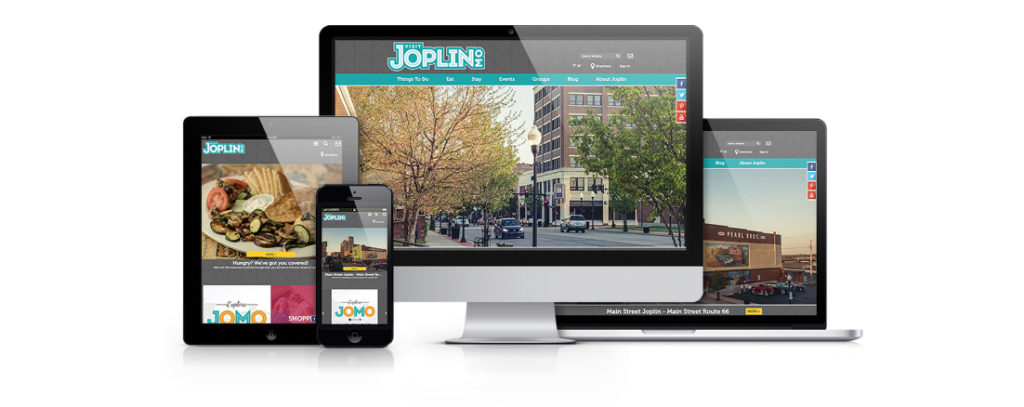
Joplin CVB Campaign Results

Not Just Your Vendor. Your Partner.
Whether you are a smaller community CVB with a team of five or less, or a big town with a fully functioning marketing department, Stealth Digital will integrate with you seamlessly to help you define and achieve your marketing goals.
We pride ourselves on our ability to be an extension of your existing marketing team, not a replacement.
We have experience working with local CVBs. We’re familiar with your pain points. We know how to address your concerns.
We are motivated to help America’s communities get back to business and we can help yours reach a larger, more optimized audience than ever.
References:
* https://www.travelagentcentral.com/hotels/stats-56-expect-to-travel-for-leisure-2021#:~:text=Compared%20to%20last%20year%2C%2036,and%20third%20quarter%20of%202021.
** https://usafacts.org/visualizations/covid-vaccine-tracker-states/
† https://www.bloomberg.com/news/articles/2020-11-16/the-american-consumer-is-flush-with-cash-after-paying-down-debt
†† https://mint.intuit.com/blog/money-etiquette/buying-local-statistics-survey/
Like most small businesses in the US, Stealth is adjusting to the new normal of social distancing. We’re working from home, taking guitar lessons on zoom and going to church on YouTube. We are finding it’s harder to decline a virtual happy hour. What can the excuse be? I am too busy. That doesn’t seem to work in times like these!
How We're Helping
As a company, we are helping our clients in different ways, depending on the category. We are reducing media for some and increasing for others. Some clients, we’re advising to keep a “heartbeat” of media going, so they can jump in faster once we are on the other side.
We are also looking at short term digital solutions and moving dollars between mediums. Social media is a good alternative! People are engaging more with family and friends and turning to social media for entertainment and news. Social allows us to stay light on our feet as messaging changes daily, sometimes hourly.
To help businesses in this time of need, we are offering a free 60-minute consultation to give you ideas and action plans for your business! Please email info@stealthcreative.com to sign up.
At Stealth, we are thankful for the internet! Right now, we are all one step from being Little House on the Prairie. We plan to take this one day at a time, but now with everyone being able to work remotely, we can take it one month at a time, which is comforting.
Take a Breather
Take a Breather
If you have anxious moments, designate 15-30 minutes each day to write down what you are worried about then cross off everything you can’t control. This exercise can be a great way to refocus on your day and enjoy time with family.
Remember the six basic emotions we all have:
- Mad
- Sad
- Scared
- Peace
- Joy
- Power
Let’s focus on Peace, Joy, Power.
Working Remotely
If you can work from home during these challenging times, remember it’s a luxury that some can’t enjoy. Embrace the back to basics shift!
We aren’t experts yet, but with a few weeks under our belts, we’ve decided to compile some tips from our employees about how they are making their home offices a productive workplace.
Here are our tips so far:
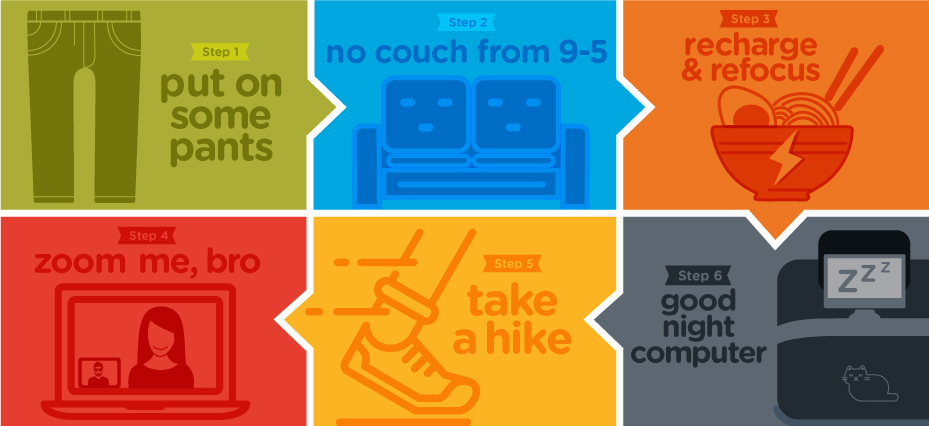
Thank You!
We are sending gratitude, love, prayers and support to the essential workers who have been working around the clock to fight COVID-19.
Life is good; you are a blessing! THANK YOU to all the businesses that made the difficult decision to work from home while we fight this virus as a country. You are making a difference.
There are 10,000 cities in the world and a $9.9 trillion tourism market.
So, who’s in charge of attracting all of those visitors (and dollars)?
Convention & Visitor Bureaus (CVBs) are the pulse of America’s local tourism industry. The CVB is the organization that pulls individuals and groups together to market their community as a whole.
Hotels, restaurants, local attractions and event promotion teams all work with their local CVB to attract visitors and locals alike to their businesses. Most CVBs get their marketing dollars from state agencies and local hotel taxes.
The job of the CVB? To make sure there are “heads in beds” at local hotels, motels and bed and breakfasts.
But what if your community doesn’t have a pro sports team, a vibrant food scene or some of the other attractions larger cities might offer?
Small markets have to unleash creativity when defining what an “attraction” is. And strategies often need an overhaul to spark the interest — or awareness — of potential visitors. (For example, growing numbers of travelers crave experiences that are “off-the-beaten-path,” or of historical significance. This is where a smaller community can shine!)
The Challenges Convention & Visitor Bureaus Face
Even after a town has identified what to say and how to say it, smaller CVBs still face key challenges.
Staffing
Most smaller communities have a similarly small CVB staff, with most headed by a single person responsible for marketing, organizing local events and overseeing social media for their region. That’s on top of the daily rigor of managing a budget, attending city functions and other administrative tasks.
No wonder self-promotion efforts get pushed to the back burner!
Budget
Basic math says that a smaller community without large-scale attractions will have less money for marketing. These communities need to work closer with local businesses so every dollar is stretched to receive the best ROI.
Attractions (or lack thereof)
One of the biggest questions smaller communities need to answer is: “What would you say… we do here?” And outsiders aren’t the only ones asking that question. If your city doesn’t have an attraction that thousands throng to every year, it’s easy for locals to think there’s nothing to do.

It all comes down to time, money and resources.
When your staff is pulled in many different directions, it’s important to bring in someone who can help take responsibilities off their plate.
Hiring an agency like Stealth Creative means, you have a whole team experienced in driving tourism, ready to assist with every aspect of your marketing plan. From marketing strategy and creative design to media placement, working with an agency increases your staff multifold. You’ve got graphic designers, digital and brand strategists, experts in all types of media placement and account executives to help keep everything on track.
No one can be an expert in everything. But you are an expert on your community. Let Stealth be the marketing experts for your community.
With more than 50 years of combined experience in CVB marketing and media placement, we know how to help you make the most of your marketing budget.
Photo Courtesy of the Joplin Convention & Visitors Bureau.
That is the question… Ah, meetings – often, a necessary evil. And when handled properly, they can be extremely effective in accomplishing business objectives, moving projects forward and opening lines of communication.
But when handled poorly, they quickly become the bane of our ‘working’ existence.
The Scenario
It’s 9:55 a.m., and a crucial meeting starts in five minutes. You grab your notebook, tablet, laptop or whatever tool you use to take notes, and head off to the meeting room. It’s pitch black. You’re the first to arrive. You sigh, roll your eyes, and head into the room, flipping on the lights and dialing into the screen-share conference call.
And…you wait. And wait. And wait. ⌛️
At 10:10 a.m., people start rolling into the meeting room. Finally, the meeting can begin. But, one of the necessary attendees still hasn’t arrived. Everyone decides to proceed, as it’s already well after the start time of the meeting.
You’re 10 minutes into the agenda (oh wait…do you have an agenda?), and that necessary attendee walks in, interrupting, and asking: What’d I miss?
Not wanting to be rude, the meeting organizer reviews what’s already been discussed, putting the entire meeting behind by yet another five minutes – and wasting the time of those who already had this discussion.
Once caught up, the meeting continues, random things are discussed in no particular order, and the meeting ends with people mostly in agreement on what was shared/talked about. Everyone heads back to their desk to continue with their day.
So…what’s wrong with this scenario? A lot.
How to Run an Effective, Efficient and Fun Meeting
Let’s talk about how to avoid the late-starting, chaotic meeting outlined above with these six steps, which we’ve also worked into an infographic.
1. Decide if a meeting is truly necessary.
We’re so in the habit of scheduling meetings that we often do it by rote. And while it’s great to get together with your fellow coworkers, clients or vendors, it’s not always necessary. Meetings take time away from and interrupt the natural workflow. It’s important to think about whether or not the value from the meeting outweighs that disruption. Things to consider:
Is the meeting more informational than discussion-based?
If it’s the former, consider sending an email to share the necessary information, and provide a way for the recipients to reach out with any questions instead of scheduling a physical meeting.
How many people need to be involved?
You know the phrase: Too many cooks in the kitchen spoil the broth? The same often holds true for meetings. Many times, the meeting organizer feels s/he must include everyone vs. paring it back to the primary decision makers who must be involved. If you want to be inclusionary, send a follow-up email or provide updates on a Slack channel or other IM platform to update the meeting attendees and those who weren’t asked to attend on what was discussed/decided.
2. Have an agenda, state your objectives and assign next steps.
I have a confession to make: When it comes to a meeting, I am not an agenda kind of person. I’m more a: Let’s-get-together-and-chat kind of person. But, I am a let’s-state-our-objectives,-recap-and-assign-next-steps kind of person. But, here’s the thing: Not everyone learns and communicates in the same way, and it’s our job as the meeting host to ensure that those who need an agenda, have one – and that we stick to it as much as possible. Each meeting invite should include the following:
1. Name/purpose of the meeting, preferably in the subject line of the invite.
Example: How to Run an Effective, Efficient & Fun Meeting
2. Description of the meeting’s purpose in the invite copy.
Example: Our objective is to walk through the key steps to ensure all of our meetings run as efficiently and effectively as they can – all while still having fun at work.
3. Attach an agenda.
- Review objectives. Walk through common scenarios/challenges of meetings.
- Review best practices.
- Decide how to modify the current process to ensure effective future meetings
- Recap & open up for discussion/questions.
- Discuss next steps.
- Assign tasks and due dates.
- Determine a follow-up time to touch base.
4. Include a call-in number or screen share when you send the invite.
This is a simple thing to do, and creates less confusion than updating an invite in the future. If there’s even a chance you’ll need it, set it up before you send the invite.
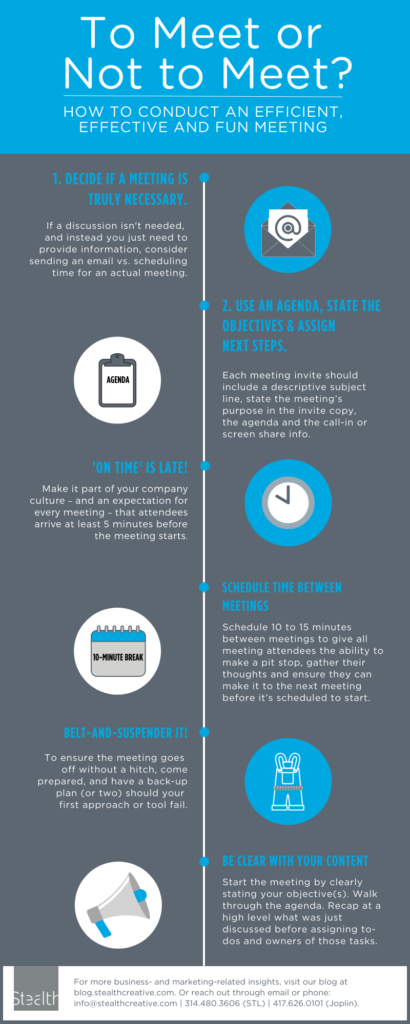
3. Use Lombardi Time.
Vince Lombardi is considered by many to be one of the greatest NFL coaches of all time, named NFL Coach of the Year twice, two-time Super Bowl champion, six-time NFL champion, and inducted into the Green Bay Packers Hall of Fame and the Washington Redskins Ring of Fame.He was famous for his ‘on-time-is-late’ philosophy, expecting his players to be 15 minutes early to games and practices, considering ‘on time’ to be late. While expecting employees to be 15 minutes early to meetings may not always be feasible – or necessary – showing up five minutes early should be doable.Arriving early allows everyone to get their coffee, get settled and have a few minutes for pleasantries before getting the meeting underway. This is essentially crucial if you’re the host. Nothing is ruder than making your clients, vendors or fellow coworkers wait because you’re running late.If you absolutely cannot make it to the meeting on time, let the host know; so they can proceed without wondering if/when you’ll be able to be there. And if you are the host, let the meeting attendees know you’re running late and what time they should join the meeting.I once had a boss who was so adamant about being on time, he’d lock the conference room doors the minute the clock struck 10 a.m. (or whatever time the meeting was supposed to start) and not allow anyone arriving after that time to even enter the room.
Now, that may be a bit extreme, but it definitely drove home the point. And I can tell you that after arriving late once, you never did it again.
Arriving a few minutes before the meeting start time shows consideration to all of the meeting attendees – whether internal or external – and helps the rest of the day stay on time.
4. Schedule time between meetings.
Many times, we’re running from meeting to meeting to meeting. And, sometimes that can’t be prevented. But many times it can.By scheduling 10 to 15 minutes in between meetings, you allow yourself – and the other meeting attendees – the ability to make a pit stop, gather their thoughts and ensure they can make it to the next meeting before it’s scheduled to start.Adding this little bit of breathing room between meetings can create a much calmer and more focused meeting environment.
5. Use the ‘belt-and-suspenders’ approach.
It may seem obvious, but it’s amazing how often the host of the meeting comes to the meeting unprepared. This often means the meeting attendees are forced to just ‘hang out’ while the host finds the files or sets up the technology needed to conduct the meeting, which wastes time for all.One of my mentors taught me the value of “belt-and-suspender-ing it,” as he called it. Essentially, always have a back-up plan (or two) should your first approach or tool fail.For example, let’s say you’re planning to show a PowerPoint presentation to a client. You have it saved to your laptop, and grab your standard projector connector before heading to the meeting at the client’s location.When you arrive, unbeknownst to you, they don’t have the same projector connection you do, and now you’re unable to easily switch to another alternative, instead having to search for a jump drive, save the file to the drive, and use the PC they have in the conference room.Uh-oh…you have a Mac. That means chances are the PC will render the PowerPoint presentation slightly differently, which could impact the overall quality of your presentation.
Had you taken the belt-and-suspenders approach, here’s how that situation would have unfolded. Before heading to the client’s, you would have:
- Saved your PowerPoint presentation as a PDF in case you had to use a different laptop or computer to show the presentation, which wouldn’t render the PPT the same way.
- Saved both the PowerPoint and PDF versions to a jump drive in case something happened to your laptop.
- Ensured you had both the pin and HDMI connectors for whichever type of projector the client may have. Maybe even called ahead to find out which type they had.
- Printed copies of the presentation as a last resort.
Taking these few small steps ensures that regardless of the situation you encounter, you’re prepared for it. Why? Because you not only have your belt, you added suspenders, too.
6. Tell them what you’re going to tell them. Tell them. Then, tell them what you told them.
To run an efficient and effective – and hopefully fun – meeting, follow these steps:
Chit-chat.
It may seem counterintuitive for an efficient meeting, but starting the meeting with a few pleasantries can actually put attendees at ease, and set the stage for a casual, relaxing meeting. Spend no more than 5 minutes on this, and preferably use the 5 minutes before the actual meeting start time to get this out of the way. After all, everyone arrived early, right?
Tell them what you’re going to tell them.
To ensure everyone’s on the same page going into the meeting, it’s important to open with the meeting’s objective: Why are we here? Even though it was originally included in the meeting invite, assume no one read it. Example: The purpose of this meeting is to walk through the key steps to ensure all of our meetings run as efficiently and effectively as they can – all while still having fun at work.
Tell them.
Whether you pull up your agenda from the meeting invite, as a separate Word doc or even have a printed copy for each attendee, share it so those folks who need to check-off items as they go, can do so – and to ensure the meeting stays on track.
Speaking of staying on track, one key component to work into your internal culture to avoid inefficiency and frustration of meeting attendees:
Do not recap for anyone who arrives late.
Make it known that if you arrive late to the meeting, you’ll have to wait until the end recap (tell them what you told them) to get caught up on what you missed. This helps drive the wanted behavior of arriving early or at the very least on time to internal meetings. (This isn’t always feasible for external or client meetings.) As you’re walking through the various agenda items, take time for discussion and questions as applicable to the different topics, ensure everyone has the opportunity to voice their opinion, and don’t be afraid to work in some humor and laughter along the way. After all, laughter has been shown to have a positive effect in the workplace.
“According to research from institutions as serious as Wharton, MIT, and London Business School, every chuckle or guffaw brings with it a host of business benefits. Laughter relieves stress and boredom, boosts engagement and well-being, and spurs not only creativity and collaboration but also analytic precision and productivity. Plus, cracking jokes at work can make people seem more competent.” ~Harvard Business Review: The Benefits of Laughing in the Office
Tell them what you told them.
Once you’ve completed the agenda, and the meeting is coming to a close, recap what was discussed. Don’t assume everyone was laser focused during the meeting. It’s possible to miss something crucial just because your mind wandered for a minute – or because you arrived late. Wrap it up by recapping what was discussed/decided – and confirm you accomplished the meeting objective shared at the start of the meeting.
Determine next steps and assign responsibility.
This is often the most overlooked step in holding a successful meeting. Everyone walks through the agenda, makes a few decisions, and heads back to their desk to continue on with their day. Unfortunately, when you reconvene to see if everything discussed was accomplished (if there were things yet to do), many items may still be left undone because everyone thought someone else was handling it. Instead, decide what the next steps and due dates are, when you’ll reconvene to ensure those items were handled, and which team member will be assigned the task and hold the responsibility for completing it on time.
Tell them what you told them – again.
Depending on the scope of the meeting, it’s often important to follow up after the meeting by sending notes to the attendees, outlining what was discussed and itemizing those to-do items just assigned. This not only puts into writing what was discussed during the meeting (perfect for visual learners vs. auditory learners), but also can inform any team members who were unable to attend what happened during the meeting.
So what do you think? To meet or not to meet?
The next time you conduct a meeting, you’ll be able to put these six steps into place to start holding efficient, effective and fun meetings at your workplace. And you’ll be amazed at how much more you get accomplished in less time, which is a win-win for all attendees – and for your business.
As always stay tuned until the next time we go Off the Radar.
Here it is: the final segment of our Agency/Client relationship series. We’ll be covering the ever-crucial task of assessing your agency’s body of work. You can catch up on our posts about deciding if you need an agency, choosing the right agency and maintaining your marketing agency relationship in case you missed them.
Now that we’ve covered how to decide if you need an agency, and understand the questions to ask … what’s next?
Welcome to Part II of our Client/Agency Relationship series. We’ve already covered how to decide if you need an agency. Now let’s talk about how to choose the right agency for you.
(more…)